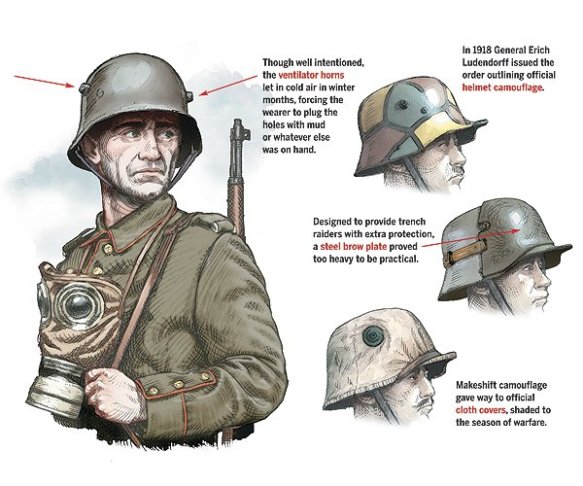1916 Stahlhelm with 1918 camouflage pattern applied in the field.
The German army’s WWI steel helmet (Stahlhelm) first appeared on the Verdun battlefield in January 1916 and was in widespread use by front-line troops on the Western Front by mid-1916. It was the result of research and experimentation conducted by Dr. Friedrich Schwerd of the Hannover Technical Institute during 1915, following his study of head wounds during the first eight months of the war, with a specific focus upon those sustained during trench warfare. The development phase compared German and Allied protective headdress, with the first Stahlhelm tested at Kummersdorf training and proving ground in November 1915 and then in the field by an infantry assault unit.174 Following the success of these trials, 30,000 helmets were ordered at the end of 1915, although its approval for general issue was not until early 1916 – hence its ‘M 1916’ designation – with the first available stocks provided to the combat units engaged at Verdun in February that year. Thereafter, the widespread issue of M 1916 helmets to the rest of the army in Europe proceeded apace.
The M 1916 (Modell 1916) Stahlhelm was pressed from silicon/nickel steel plate and designed to cover and protect the head from mid-forehead to the nape of the neck. It weighed approximately 1.13 kilograms. The front edge was drawn forward into a form of peak, affording additional protection to the wearer’s eyes while still allowing him to aim and fire his weapon. Its distinctive shape and similarity to a coal-scuttle resulted in the Stahlhelm being accorded that name by the opposing Allied troops. In addition to the standard pattern steel helmet, an M 1918-pattern Stahlhelm with more flared and cut-away side edges was produced to reduce the echo effect and reduced hearing experienced with the M 1916 model.175 Externally, two small lugs or horns at the sides provided ventilation holes, which were also the points at which snipers could attach a separate steel visor (Stirnpanzer) to give them additional protection when in long-term static positions engaged in sniping tasks. These helmet visors, which first appeared in March 1916, were also made available to sentries, trench raiding parties and machine-gunners, but the weight of the Stirnpanzer was too great for its more general use. The latter troops (and other individuals where their frontline task or operational situation so required) were also issued with segmented steel-plate body armour designed to protect the upper body while operating their machine-guns. A one-piece leather chin-strap held the helmet securely on the head, being attached by M1891 chinstrap lugs of the same type used on the Pickelhaube, while internally a liner in the form of three segmented padded leather pouches provided a degree of comfort to the wearer; even so, the Stahlhelm was inevitably much heavier and less comfortable than the Pickelhaube. The steel shell was generally issued in sizes 60 to 68, although a size 70 could also be provided if required. An M 1917-pattern Stahlhelm featured an improved liner but was otherwise unchanged from the M 1916 model. Finally, the M 1918-pattern helmet referred to above had a two-piece chin-strap attached directly to the liner rather than to the steel shell, in addition to the cutaway skirt and a more rounded overall profile.
The Stahlhelm was issued painted in various shades of field grey, the precise shade dependent upon the original manufacturer and specific ordnance department providing the helmet. However, in front-line use the need to reduce any metallic shine and to blend into the local terrain resulted first of all in helmets simply being daubed with mud and later in a wide variety of paint schemes being applied to them. These multi-colour patterns were variously mottled, segmented, geometric or random, utilizing all shades of green, grey, blue, black, red, brown and yellow. Some units standardized the pattern and colours used; others simply allowed the troops to adopt the most appropriate scheme for their own particular area or role. Not until 7 July 1918 was the camouflage painting regularized by Army Order II, No. 91366, which directed that helmets were to be painted in several colours appropriate to the season (for example, brown, green and ochre were to be used in summertime) with each coloured segment or area separated by a finger-wide black line. Improvised cloth covers and attached foliage were used from an early stage, with officially produced cloth covers in white and grey also being issued during late 1916 and early 1917, although camouflage paint schemes generally continued to be the preferred option.
Although the ventilator horns allowed cold air to enter, and so were often necessarily blocked with mud or fabric in winter, and the flared skirt of the helmet distorted or blocked the wearer’s hearing to some extent, the innovative functional design and consequent protection afforded by the Stahlhelm represented a significant advance in the protection and effectiveness of the front-line soldier. It undoubtedly reduced the incidence of death and injury to German troops from 1916 – especially those caused by artillery bombardment, hand grenades and other forms of high-explosive, fragmentation and shrapnel attack, as well as by falling debris. The other Central Power armies used various versions of the M 1916, M 1917 and M 1918 Stahlhelm, modified to meet their specific requirements.
